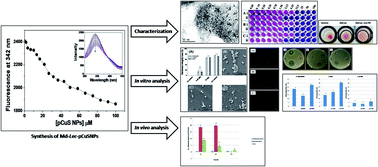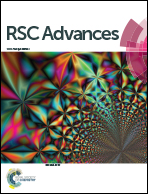Shrimp lectin (Md-Lec) conjugated copper sulfide nanoparticles enhance the elimination of aquatic pathogens in infected Nile tilapia (Oreochromis niloticus)†
Abstract
Lectins are known for their ability to bind to cell surface glycans, and are useful to develop a glycan-targeted drug delivery system. This study aimed to evaluate the capacity of pectin capped copper sulfide nanoparticles (pCuS NPs) to modulate the antibacterial activity of a lectin, Md-Lec, purified from the shrimp, Metapenaeus dobsoni. Fluorescence spectroscopy revealed that Md-Lec has the ability to form a complex with pCuS NPs. Haemagglutination assay showed that the carbohydrate binding site of the lectin was preserved even after complexing with pCuS. The minimum inhibitory concentrations (MICs) obtained for Md-Lec and pCuS NPs against the tested aquatic pathogens were 50 μg ml−1 and 12.5 μM, respectively. Interestingly, the MIC of Md-Lec–pCuS NPs complex was four fold lower than that of pCuS, which was attributed to the bacterial cell surface glycan recognization activity of Md-Lec. Zone of inhibition assay showed that the zone size was highest for the lectin conjugated nanoparticles. Mechanistic study revealed that Md-Lec–pCuS NPs affect the bacterial membrane integrity and produce a large volume of reactive oxygen species to kill the bacteria. The practical aspect of using this lectin–pCuS NPs complex was evaluated by treating bacteria infected Nile tilapia (Oreochromis niloticus). The bacterial load was much less in the lectin–pCus NPs complex treated fish; moreover, the fish fully recovered from the infection. It was concluded that the conjugate of antibacterial lectin and NPs is more effective than the individual components.



 Please wait while we load your content...
Please wait while we load your content...